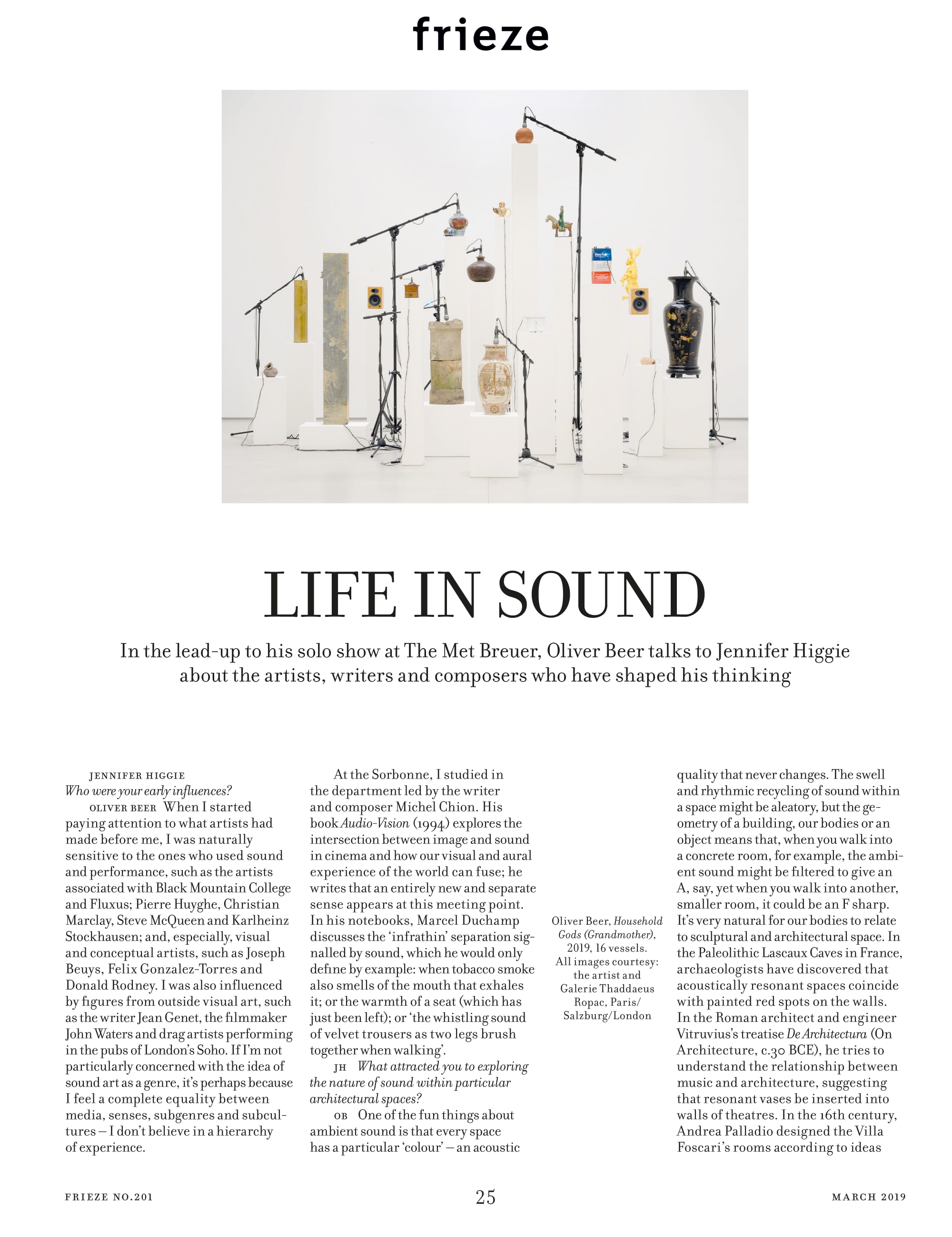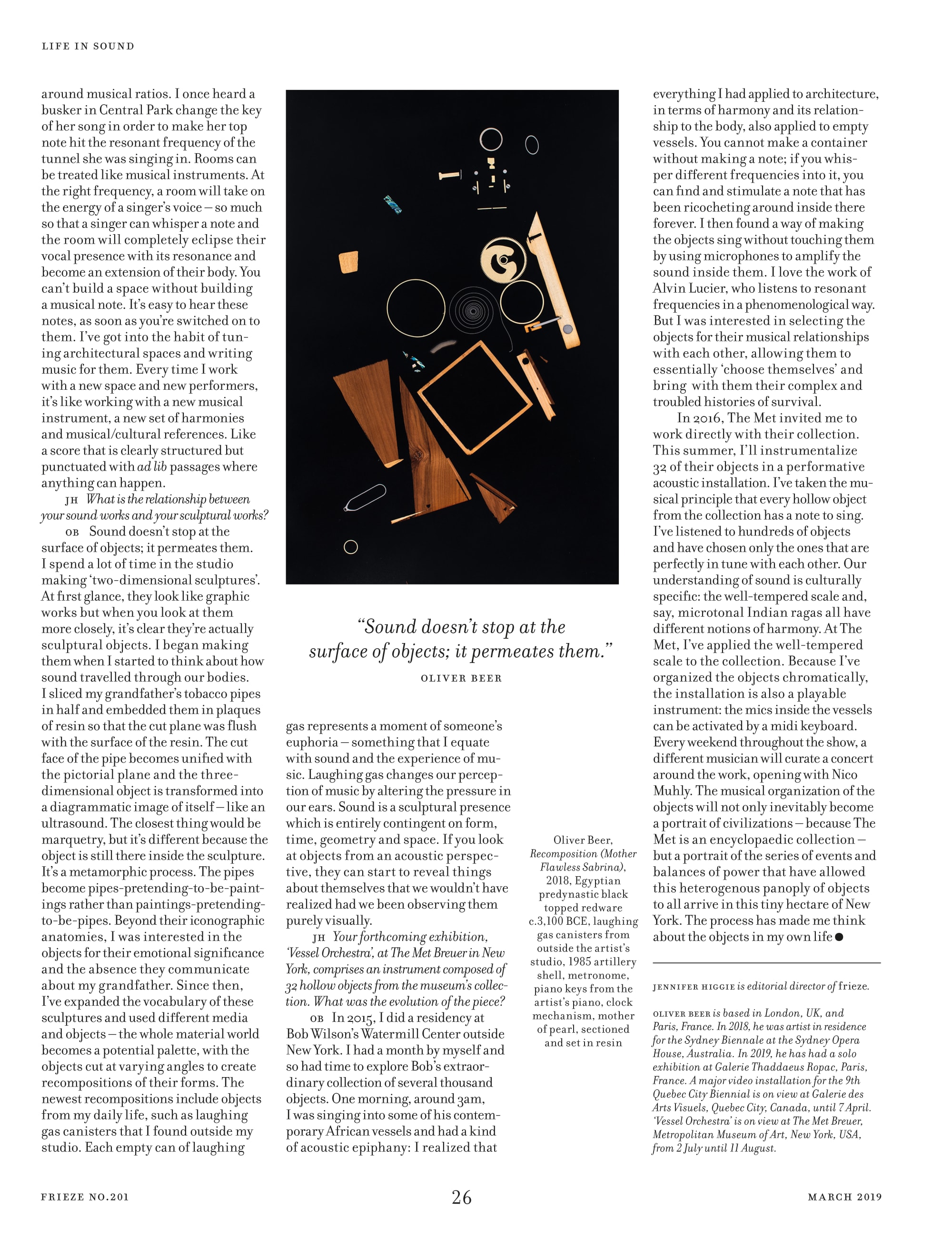Jennifer Higgie: Who were your early influences?
Oliver Beer: When I started paying attention to what artists had made before me, I was naturally sensitive to the ones who used sound and performance, such as the artists associated with Black Mountain College and Fluxus; Pierre Huyghe, Christian Marclay, Steve McQueen and Karlheinz Stockhausen; and, especially, visual and conceptual artists, such as Joseph Beuys, Felix Gonzalez-Torres and Donald Rodney. I was also influenced by figures from outside visual art, such as the writer Jean Genet, the filmmaker John Waters and drag artists performing in the pubs of London’s Soho. If I’m not particularly concerned with the idea of sound art as a genre, it’s perhaps because I feel a complete equality between media, senses, subgenres and subcultures – I don’t believe in a hierarchy of experience.
At the Sorbonne, I studied in the department led by the writer and composer Michel Chion. His book Audio-Vision (1994) explores the intersection between image and sound in cinema and how our visual and aural experience of the world can fuse; he writes that an entirely new and separate sense appears at this meeting point. In his notebooks, Marcel Duchamp discusses the ‘infrathin’ separation signalled by sound, which he would only define by example: when tobacco smoke also smells of the mouth that exhales it; or the warmth of a seat (which has just been left); or ‘the whistling sound of velvet trousers as two legs brush together when walking’.
JH:What attracted you to exploring the nature of sound within particular architectural spaces?
OB:One of the fun things about ambient sound is that every space has a particular ‘colour’ – an acoustic quality that never changes. The swell and rhythmic recycling of sound within a space might be aleatory, but the geometry of a building, our bodies or an object means that, when you walk into a concrete room, for example, the ambient sound might be filtered to give an A, say, yet when you walk into another, smaller room, it could be an F sharp. It’s very natural for our bodies to relate to sculptural and architectural space. In the Paleolithic Lascaux Caves in France, archaeologists have discovered that acoustically resonant spaces coincide with painted red spots on the walls. In the Roman architect and engineer Vitruvius’s treatise De Architectura (On Architecture, c.30 BCE), he tries to understand the relationship between music and architecture, suggesting that resonant vases be inserted into walls of theatres. In the 16th century, Andrea Palladio designed the Villa Foscari’s rooms according to ideas around musical ratios. I once heard a busker in Central Park change the key of her song in order to make her top note hit the resonant frequency of the tunnel she was singing in. Rooms can be treated like musical instruments. At the right frequency, a room will take on the energy of a singer’s voice – so much so that a singer can whisper a note and the room will completely eclipse their vocal presence with its resonance and become an extension of their body. You can’t build a space without building a musical note. It’s easy to hear these notes, as soon as you’re switched on to them. I’ve got into the habit of tuning architectural spaces and writing music for them. Every time I work with a new space and new performers, it’s like working with a new musical instrument, a new set of harmonies and musical/cultural references. Like a score that is clearly structured but punctuated with ad lib passages where anything can happen.

JH: What is the relationship between your sound works and your sculptural works?
OB:Sound doesn’t stop at the surface of objects; it permeates them. I spend a lot of time in the studio making ‘two-dimensional sculptures’. At first glance, they look like graphic works but when you look at them more closely, it’s clear they’re actually sculptural objects. I began making them when I started to think about how sound travelled through our bodies. I sliced my grandfather’s tobacco pipes in half and embedded them in plaques of resin so that the cut plane was flush with the surface of the resin. The cut face of the pipe becomes unified with the pictorial plane and the three-dimensional object is transformed into a diagrammatic image of itself – like an ultrasound. The closest thing would be marquetry, but it’s different because the object is still there inside the sculpture. It’s a metamorphic process. The pipes become pipes-pretending-to-be-paintings rather than paintings-pretending-to-be-pipes. Beyond their iconographic anatomies, I was interested in the objects for their emotional significance and the absence they communicate about my grandfather. Since then, I’ve expanded the vocabulary of these sculptures and used different media and objects – the whole material world becomes a potential palette, with the objects cut at varying angles to create recompositions of their forms. The newest recompositions include objects from my daily life, such as laughing gas canisters that I found outside my studio. Each empty can of laughing gas represents a moment of someone’s euphoria – something that I equate with sound and the experience of music. Laughing gas changes our perception of music by altering the pressure in our ears. Sound is a sculptural presence which is entirely contingent on form, time, geometry and space. If you look at objects from an acoustic perspective, they can start to reveal things about themselves that we wouldn’t have realized had we been observing them purely visually.
JH: Your forthcoming exhibition, ‘Vessel Orchestra’, at The Met Breuer in New York, comprises an instrument composed of 32 hollow objects from the museum’s collection. What was the evolution of the piece?
OB: In 2015, I did a residency at Bob Wilson’s Watermill Center outside New York. I had a month by myself and so had time to explore Bob’s extraordinary collection of several thousand objects. One morning, around 3am, I was singing into some of his contemporary African vessels and had a kind of acoustic epiphany: I realized that everything I had applied to architecture, in terms of harmony and its relationship to the body, also applied to empty vessels. You cannot make a container without making a note; if you whisper different frequencies into it, you can find and stimulate a note that has been ricocheting around inside there forever. I then found a way of making the objects sing without touching them by using microphones to amplify the sound inside them. I love the work of Alvin Lucier, who listens to resonant frequencies in a phenomenological way. But I was interested in selecting the objects for their musical relationships with each other, allowing them to essentially ‘choose themselves’ and bring with them their complex and troubled histories of survival.
In 2016, The Met invited me to work directly with their collection. This summer, I’ll instrumentalize 32 of their objects in a performative acoustic installation. I’ve taken the musical principle that every hollow object from the collection has a note to sing. I’ve listened to hundreds of objects and have chosen only the ones that are perfectly in tune with each other. Our understanding of sound is culturally specific: the well-tempered scale and, say, microtonal Indian ragas all have different notions of harmony. At The Met, I’ve applied the well-tempered scale to the collection. Because I’ve organized the objects chromatically, the installation is also a playable instrument: the mics inside the vessels can be activated by a midi keyboard. Every weekend throughout the show, a different musician will curate a concert around the work, opening with Nico Muhly. The musical organization of the objects will not only inevitably become a portrait of civilizations – because The Met is an encyclopaedic collection – but a portrait of the series of events and balances of power that have allowed this heterogenous panoply of objects to all arrive in this tiny hectare of New York. The process has made me think about the objects in my own life.
Oliver Beer is based in London, UK, and Paris, France. In 2018 he was artist in residence for the Sydney Biennale at the Sydney Opera House, Australia. In January, he had a solo exhibition at Galerie Thaddaeus Ropac, Paris, France. A major video installation for the 9th Quebec City Biennial is on view at Galerie des Arts Visuels, Quebec City, Canada, until 7 April. ‘Vessel Orchestra’ is on view at The Met Breuer, Metropolitan Museum of Art, New York, USA, from 2 July until 11 August.
This article first appeared in frieze issue 201 with the headline ‘Life In Sound’



